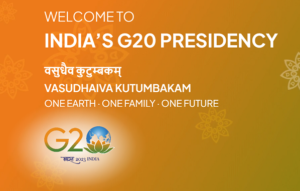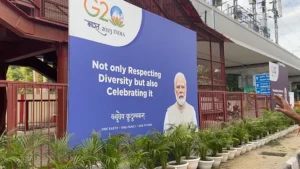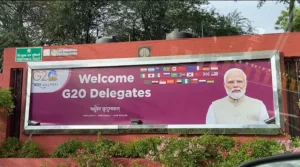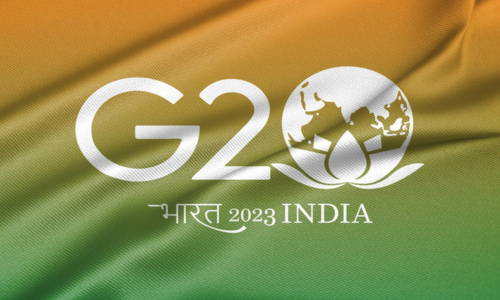In the realm of marketing, the phrase “global stage” might conjure visions of flashy product launches, celebrity endorsements, and catchy jingles.
But, believe it or not, a nation’s performance on the international diplomatic stage can be a masterclass in marketing finesse. India’s dazzling display at the G20 Summit in Delhi offers us a front-row seat to witness this diplomatic and branding spectacle. So, grab your popcorn, folks, as we take a closer look at India’s showmanship at the G20 Summit and draw some valuable lessons for marketers worldwide.
Getting Ready to Schmooze Like a Diplomat
Before we delve into the glitz and glamour of marketing strategies, let’s start at the very beginning – preparation. India’s game plan leading up to the G20 Summit resembled a meticulously orchestrated symphony of statesmanship. Instead of keeping brainstorming sessions confined to the marketing and digital gurus, they opened up the discussion to a diverse range of stakeholders. This inclusive approach mirrored the principles of modern business management – collaboration and consensus-building.

Image Courtesy: Wikipedia
In a world where we’re more interconnected than ever, India’s approach of amplifying the voices of developing nations showcased the power of inclusive marketing. The lesson here is as clear as a polished crystal: collaboration is the secret sauce of successful marketing, whether you’re on the global diplomatic stage or sitting in your corporate boardroom, contemplating your next ad campaign.
Crafting the Perfect Message – No Pressure!
With preparation as the backbone, India’s marketing brilliance shone through in their careful selection of messaging. Rather than bombarding the audience with a marketing blitzkrieg, they chose their medium and message with surgical precision. The resonance of ‘Vasudhaiv Kutumbkum,’ signifying interconnectedness, was palpable. It’s a reminder that the right message tailored to the right audience elicits the most significant response and engagement.

Image Courtesy: India Ties
In the world of marketing, this principle rings true like a timeless jingle. A well-crafted message, aligned with the values and aspirations of your target audience, can work wonders. Remember, it’s not about shouting the loudest; it’s about speaking to the hearts and minds of your audience – a bit like composing a chart-topping song.
Timing, My Dear Watson, Timing!
Timing played a pivotal role in India’s success. With the world’s eyes fixed on the G20 Summit, India demonstrated the importance of patience. They spent over a year building consensus on critical matters and strategically delivered their messaging during the Summit itself. This calculated approach resulted in an inclusive declaration that transcended national boundaries and silenced opposing voices.
In marketing, as in diplomacy, timing is everything. Knowing when to launch a campaign, introduce a product, or engage with your audience can make or break your efforts. It’s about being in sync with the zeitgeist, just as India was at the G20 Summit – they hit the diplomatic catwalk at just the right moment.
Being Prepared for Curveballs
India’s diplomatic finesse was most evident when faced with unexpected challenges, such as China and Saudi Arabia’s objection to joining the G20 tourism meets and the non-participation of two key leaders. Their adaptability and ability to pivot showcased the importance of having contingency plans, not just in diplomacy but also in marketing. It’s a valuable lesson that every business should embrace to protect itself from unforeseen shocks. After all, even the best marketing plans can sometimes unravel faster than a cheap sweater in a rainstorm.
In marketing, unforeseen challenges can emerge like surprise party crashers. It could be a sudden shift in consumer preferences, a disruptive technology, or a global crisis – you know, the usual suspects. The ability to adapt and have contingency plans in place can be the difference between thriving and floundering in the turbulent sea of commerce.
Follow-Up – Not Just for Stalkers
Post-event analysis is critical for growth. India’s Prime Minister set a commendable example by convening a follow-up virtual meeting for G20 leaders to review progress. This practice ensures a seamless transition from one endeavour to the next, emphasizing the importance of continuous learning and improvement.
In marketing, too, the journey doesn’t end when the campaign is over. Analyzing the results, gathering feedback, and making improvements are essential steps in the process. It’s about building on your successes and learning from your failures, not stalking your potential customers like a creepy ex.
Digital Marketing, Social Media, and Influencers: The Sizzle on the Diplomatic Steak
India’s G20 Summit wasn’t just a diplomatic feat; it was a marketing triumph. They harnessed the power of digital marketing and social media, reaching a global audience in real-time, fostering engagement and information dissemination.
Platforms like X, Instagram, and Facebook were buzzing with official G20 Summit updates and captivating content.

India’s marketing strategy emphasized collaboration, economic stability, and global governance, positioning the G20 as a forum for tackling pressing global issues.

Moreover, India’s multimedia advertising campaign encompassed print, television, and radio, but also threw in interactive content like videos and webinars to keep audiences hooked. Collaborations with reputable media outlets, both domestic and international, highlighted India’s role as a host, fostering a positive image and stimulating interest in the event. Eye-catching posters, billboards, and banners dotted major cities, drawing the public’s attention to the G20 Summit like a moth to a dazzling diplomatic flame.
Boosting Tourism Prospects – Come for the Summit, Stay for the Curry
The G20 Summit wasn’t just about diplomacy and economics; it was also a unique platform for promoting India’s tourism industry. India’s geographical diversity, stretching from Arunachal Pradesh to Kashmir, showcased its potential as a multifaceted tourist destination. Strategic marketing campaigns highlighted the nation’s breathtaking landscapes, diverse culture, and rich heritage.
The tourism sector witnessed remarkable growth, with premium hotels fully occupied by delegates, generating revenues surpassing annual incomes. As the world reflects on the outcomes of the summit, India’s marketing approach stands as a shining example of how effective promotion can elevate a nation’s global image and prospects. It’s like inviting the world over for a diplomatic soirée and then seducing them with your stunning landscapes and scrumptious cuisine. Bravo, India!
A Boost to Brand India – From Curry to Credibility
The G20 Summit has not only elevated India’s diplomatic standing but also given a significant boost to Brand India. CEOs and business leaders acknowledge the positive impact of the G20 on the nation’s brand image. The event served as a platform to showcase India’s strengths and capabilities on the global stage, reinforcing its position as an emerging economic powerhouse.
Significance for Marketing Agencies – The Diplomatic Dividend
India’s G20 Presidency extends its impact beyond diplomacy. Marketing agencies in India stand to benefit from several aspects of this global event:
- Economic Policy Impact: India’s influence on economic policies can lead to a flourishing economy, translating into larger marketing budgets and opportunities for agencies.
- Sustainability Focus: The rising demand for sustainable marketing aligns with G20 discussions on sustainability, presenting opportunities for agencies promoting eco-friendly strategies.
- Digital Transformation: Policies favoring digital innovation can benefit digital marketing and technology-driven advertising-focused agencies.
- Global Partnerships: G20 alliances provide agencies access to international markets and innovative marketing strategies.
- Enhanced Reputation: India’s elevated global standing enhances the reputation of India-based marketing agencies.
- Human Capital Development: Efforts to foster entrepreneurship and human capital can indirectly benefit agencies by promoting innovation.
- Cultural Exchanges: Agencies can play a vital role in encouraging cultural exchanges, increasing opportunities for tourism and business.
The Bharat Mandapam – Where Tradition Meets Technology
In the heart of the G20 Summit in Delhi, amidst grandeur and historic significance, stood the iconic Bharat Mandapam—an embodiment of India’s rich cultural heritage and technological prowess. This exceptional venue showcased India’s commitment to seamlessly blend tradition with innovation while fostering unity and a positive image of the government. Through breath-taking visuals and immersive displays, it depicted India’s diversity and cultural richness, leaving an indelible mark on the international audience. Underpinning it all was the symbolic shift from “India” to “Bharat,” a call to preserve and promote the nation’s cultural heritage.
Technology at Its Finest – Tradition with a Digital Twist
But this wasn’t just a celebration of tradition; it was a seamless fusion of tradition and technology. Cutting-edge technology was deployed to host and demonstrate India’s cultural prowess. From interactive holographic displays showcasing ancient art forms to virtual reality experiences that transported visitors to historical landmarks, technology played a pivotal role in enhancing the overall experience.

Image Courtesy: Khaleej Times
Showcasing India’s Prowess – Tradition with a Dash of Swagger
More than a visual spectacle, the Bharat Mandapam was a powerful statement of India’s capabilities. It sent a resounding message that India could seamlessly marry its cultural heritage with modern technology. This not only created a positive image of the government but also inspired a sense of pride among the Indian audience, reinforcing the idea that preserving cultural heritage and embracing technology can go hand in hand.

Image Courtesy: NDTV
Embracing Cultural Roots in Amritkaal – Tradition with a Fresh Twist
The transition from “India” to “Bharat” was not a mere shift in nomenclature but a deliberate call to embrace the nation’s cultural heritage at its core, especially in the era of Amritkal. This transformation sent a powerful message, uniting people across the political spectrum. It served as a bridge between tradition and progress, fostering unity and bringing electoral constituents closer to the government’s agenda of preserving our cultural roots while embracing the digital age.
In Conclusion – The Marketing Universality
India’s G20 triumph is more than just a diplomatic success; it’s a beacon of excellence for marketers seeking to leave their mark on the global stage. It’s a testament to the power of collaboration, strategic messaging, timing, adaptability, and the art of follow-up. Moreover, it showcases how digital marketing, social media, and technology can elevate global promotion.
For marketing agencies, India’s G20 Presidency offers a treasure trove of opportunities. It’s a chance to influence economic policies, promote sustainability, capitalize on digital transformation, forge global partnerships, enhance reputations, and facilitate cultural exchanges.
The Bharat Mandapam, with its seamless integration of tradition and technology, exemplifies India’s ability to bridge the past and the future. It’s a remarkable showcase of how preserving cultural heritage can be intertwined with technological innovation to foster unity and pride.
In a world where marketing extends its reach from products and services to nations and diplomacy, India’s G20 triumph reminds us that the principles of marketing are universal. Whether you’re promoting a brand or a nation, the fundamentals remain the same: understand your audience, craft compelling messages, choose the right timing, be adaptable, and follow up for continuous improvement.
As we continue navigating the ever-evolving landscape of marketing, let India’s G20 triumph serve as an enduring source of inspiration—an example of how marketing, in all its forms, can shape perceptions, drive growth, and foster unity on the global stage. It’s a marketing marvel worth celebrating!

